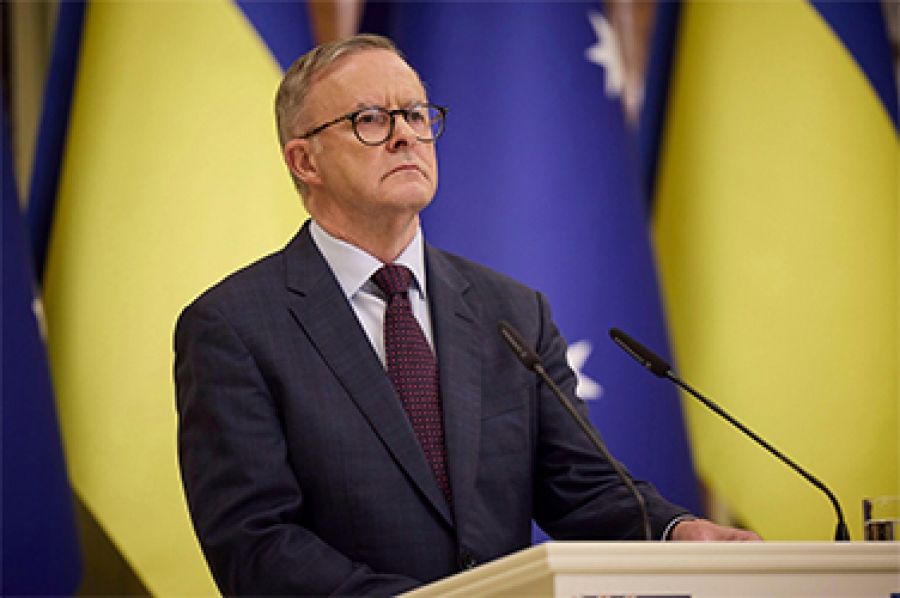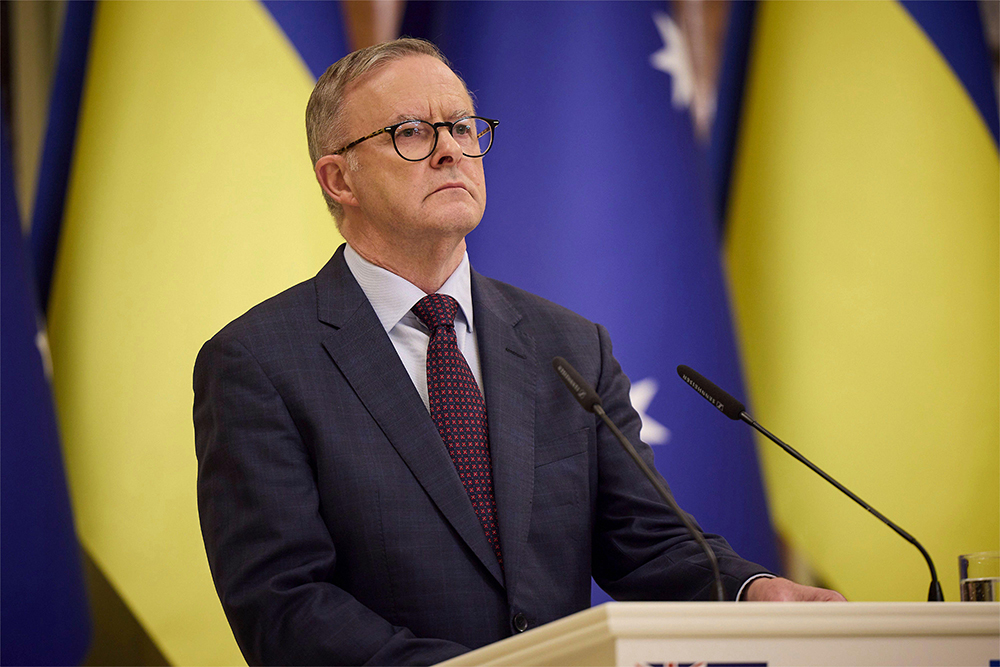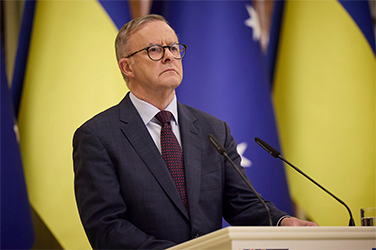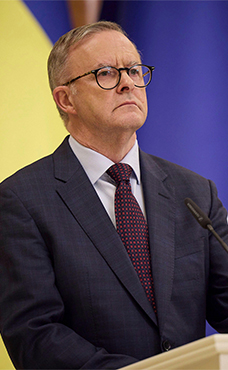
- Free Article: No
- Contents Category: Commentary
- Custom Article Title: The power of office
- Review Article: Yes
- Article Title: The power of office
- Online Only: No
- Custom Highlight Text:
Before the May 2022 federal election, Anthony Albanese, partly to silence critics of his ‘small target’ campaign and partly to manage wider expectations, proposed to lead a Labor government that under-promised and over-delivered. A deliberately thin ‘look-at-them’ election campaign was designed to keep the focus on a tired and compromised Coalition government, rather than following Labor’s usual approach of fighting for voters’ attention with big new ideas. For a social democratic party which exists for reform, it was an unorthodox strategy and one not without risks. The political capital from any ‘over-delivery’ might well accumulate for a ‘re-election’ bid in 2025, but the thinness of Labor’s 2022 enticements would be obvious.
- Article Hero Image (920px wide):

- Article Hero Image Caption: Australian Prime Minister Anthony Albanese (photograph via Ukraine Presidents Office/Alamy)
- Alt Tag (Article Hero Image): Australian Prime Minister Anthony Albanese (photograph via Ukraine Presidents Office/Alamy)
- Featured Image (400px * 250px):

- Alt Tag (Featured Image): 'The power of office' by Mark Kenny
For progressives, the election presented slim pickings, even frustration. In the absence of the redistributive tax-reform measures (and accompanying class rhetoric) offered up by Bill Shorten in 2019 around negative gearing, capital gains tax concessions, and franking credits, some feared Labor was not giving its own supporters enough to rally around, and others enough reason to switch.
Yet despite his own problems on the campaign trail, Albanese held his nerve, convinced that the election had to be about Scott Morrison’s failures rather than Labor’s plans. Accordingly, he would commit not only to match – and thus to validate – Morrison’s piecemeal and temporary cost-of-living ‘band-aids’ for households, but also to honour the Liberals’ Stage 3 income tax cuts for high-income earners from 2024, despite their colossal cost, vaulting unfairness, and implications for wider reform.
And there was more. Foreign and strategic policy would also continue unchanged, with Labor stressing its undying fidelity to the primacy of the US alliance, to the newly struck AUKUS arrangement, replete with its pie-in the-sky nuclear-powered submarines, and to the continuation of Australia’s defiance of Beijing. Calls for a greater self-reliance in foreign and defence policy, from Labor heavyweights and respected academics, would go unheeded as Labor emphatically aligned itself with the Coalition.
Rhetorically, Albanese’s ‘under-promise, over-deliver’ theme had other useful dimensions. First, by way of contradistinction, it proclaimed a clear alternative to Morrison’s unctuous habit of talking big and doing little. Albanese would flip that around. Second, it hinted to engaged and progressively minded voters – call it a positive dog-whistle – that although Labor’s presentation was cautious, that sparseness might itself offer hope. In other words, the election offering was not exhaustive – there would be scope for creative policy initiatives that had not been openly canvassed during the campaign.
The unromantic calculus at the heart of all this was the product of Albanese’s long parliamentary career, during which he had witnessed Labor’s many disappointments. The party had held office federally for only twenty-six years since World War II and, of the past twenty-five, spent just six difficult years on the treasury benches.
Albanese never doubted that he would face criticism for his so-called ‘small target’ approach, but he believed the task of winning from opposition was best viewed as functionally discrete from the opportunities for governing once in office. His critique stood on two truths: first, that the voters he needed to attract had voted conservative in 2019, and had done so for a reason. Among this cohort were the usual undecided or ‘swing’ voters who had told pollsters they favoured Shorten’s Labor but had then equivocated in the polling booth.
These voters were still there to be won, and by 2022 they had been joined a new subset: educated and affluent Liberal supporters unimpressed by Morrison’s cloying religiosity, his ‘not-my-job’ slipperiness through the bushfires and the pandemic, and his dishonesty. Among this group, there was also deep frustration over the Coalition’s climate denialism, and its penchant for divisive culture wars against universities, the arts, the ABC, and even women. Some of these voters were breaking free for the first time.
What they needed in order to snap the habit of a lifetime was reassurance. For such voters, Labor’s message had to be one of safety, permission even, derived from a sense of major policy continuity under Labor, particularly vis-à-vis the economy. The successful community independent candidate in the safe Liberal seat of Goldstein, Zoe Daniel, harnessed this sentiment well with her campaign slogan, ‘Same isn’t safe’.
Albanese’s recognition of the need to prise these Liberals away, formed the second part of his thinking, namely, his working assumption that any primary votes bled off on Labor’s left flank from courting disaffected Liberals would probably wind up back in Labor’s column anyway – through preference flows. Except in Queensland, where Greens candidates snagged three seats, this confidence was largely vindicated in the result. It explains how Labor could simultaneously slip backwards on first-preference votes – the lowest share of any incoming federal government – and yet go forwards on two-party-preferred, with a 52.1 per cent share to the Coalition’s 47.9 per cent which represents a swing to Labor of 3.66 per cent.
Successive elections will reveal which was the more permanent shift in 2022 – the extraordinary emergence of the Teal independents in Liberal strongholds, or the long-foreshadowed (and finally realised) incursion of Greens into Labor’s lower-house territory. But it is the latter development that will have the most material effect on the new government’s capacity to deliver – not because of the Greens’ lower-house gains, but because of their enhanced leverage in the Senate. To pass any bills opposed by the Coalition, the new government needs thirty-nine votes in the Upper House: its own twenty-six plus the Greens Party’s twelve and one other.
How tricky will that be? Before the forty-seventh Parliament even sat for the first time, both avenues had been narrowed if not closed entirely on one of the measures most central to the election result: emissions reduction. Opposition Leader Peter Dutton declared that the Coalition will not support Labor’s forty-three per cent 2030 target, leaving Albanese with little choice but to secure support from the Greens Party or pursue it non-legislatively.
Sparking memories of his party’s role in scuppering Kevin Rudd’s Carbon Pollution Reduction Scheme in 2009, Greens Party leader Adam Bandt flagged big problems with Labor’s 2030 target, while leaving open at least the possibility of compromise. The failure of Rudd’s signature reform touched off a series of political eruptions which were material in elevating Tony Abbott to the Liberal leadership (and ultimately the prime ministership in 2013), ending Kevin Rudd’s first-term premiership (2007–10), holing Julia Gillard’s leadership below the waterline, and stalling effective climate and energy policy for a dozen years. Few in Labor believe the Greens will ultimately find their way to a compromise.
Yet for all these problems and despite the relative modesty of Labor’s formal campaign offering, morale in Canberra has risen markedly since the May poll. The immediate aftermath of the election revealed just how many ways there are for a new government to change conversations, expand possibilities, restore trust, and create hope. This is the power of office. It brings the ability to set a tone for good or ill, to prioritise expenditure, establish programs, send messages, and build a nation. One is reminded of Paul Keating’s 1996 observation: ‘When you change the government you change the country.’
Fifty years before Anthony Albanese, it was Gough Whitlam.
Shortly before the 2022 election, I wrote in The Conversation that were Albanese to be elected he proposed to do less over a whole term than Whitlam fired off in his first furious month. At that time, the two leaders looked as different as chalk and cheese. Where the mellifluous and supremely confident Whitlam proposed a big reform agenda involving sweeping social and political modernisation of Australia, a defensive Albanese appeared to offer incrementalism.
This contrast looked only more stark when considering Whitlam’s first month in office (December 1972), during which he established diplomatic relations with Peking (now Beijing), following his audacious trip to ‘Red China’ in 1971. Dramatic and decisive, it was part of an Australian reimagining which the late historian Stuart Macintyre had labelled ‘a nationalism attuned to internationalism’. Hurrying on, Whitlam ended military conscription and pulled Australia out of the Vietnam War; granted independence to Papua New Guinea; and ratified international conventions on labour conditions, racial non-discrimination, and nuclear weapons proliferation.
Big changes. Multiple fronts. Yet if anything, Albanese’s first month was equally active and even more ‘international’, giving credence to his view that campaigning and governing, however sequential, were such distinct endeavours as to adduce two different Albaneses.
In its first thirty days in office, the government made a minimum wage case submission in support of the lowest paid getting a wage rise of 5.1 per cent (i.e. matching inflation, for which Albanese was called a ‘loose economic unit’ by Morrison). The independent Fair Work Commission went even further.
With just five ministers sworn in to hold all portfolios, the government swiftly returned the Murugappan family (also known as the Nadesalingam family) to Biloela, ending a sad and inhumane saga that had served nobody’s interests but the Coalition’s.
The new government then formally notified the United Nations that Australia had adopted the forty-three per cent emissions cut for 2030. It also launched a new charm offensive in the region to assert Australian primacy as the economic and security lodestar of the south Pacific (aided substantially by the new climate stance). Between them, Albanese, Foreign Minister Penny Wong, and Defence Minister Richard Marles visited Fiji, Solomon Islands, Indonesia, Japan, Singapore, India, and more.
On the domestic front, Albanese raised the 2017 Uluru Statement from the Heart in his victory speech on election night, ahead of any other policy. The atmospheric change from that commitment alone felt transformative. In another telling surprise just days later, the new prime minister appointed a Minister for the Republic (Matt Thistlethwaite), prompting monarchists to complain that he was the first minister of the Crown dedicated to the removal of the Crown.
The government also removed the religious requirement from the Howard-era School Chaplaincy program to allow secular counsellors to be employed, and settled the financial costs to be paid to the French Naval Group for the cancelled submarines program.
Across the Australian Public Service, Morrison appointees were replaced with fully credentialled top-level public servants. In one of his first acts after the 2019 election, Morrison had delivered a patronising lecture to public servants widely interpreted as telling them to stick to service delivery and leave the policy ideas to the government. Given such statements, the growing use of external consultants, and key political appointments, morale had tanked. Sources within the APS say there is now hope for a more vigorous, respected, and yet depoliticised public service.
Yet problems are legion. Inflation has spiked, causing interest rates to rise sharply. The new Minister for Aged Care, Anika Wells, told Radio National in July that the federal budget was ‘not just a mess but was booby-trapped’, with a raft of measures funded only until December. One that ended on 30 June, the $750 pandemic leave for workers without sick leave, caught Labor immediately. With infections soaring from a third Omicron sub-variant wave for the year, Wells, one of Labor’s bright new talents, said the funding was not being cut but was instead expiring. It was the kind of sophistry of which the Morrison government was fond. The government was forced into its first big reversal.
At fifty-nine, Albanese has seen all three of the new Labor governments since World War II. Each of them – for good or bad – has informed his thinking. From Whitlam has come the social reform zeal, an effervescent internationalism, and a certain joie de vivre; from Bob Hawke and Paul Keating, the insistence on thoroughly professional cabinet government, and the value of bringing interests together in pursuit of consensus; from Kevin Rudd and Julia Gillard, two more lessons: Rudd’s deft positioning to give voters the safe option of leaving Howard; and from Gillard, the harsh truths that conservatives play for keeps and that internal rivalries end up taking everyone down.
This article, one of a series of ABR commentaries addressing cultural and political subjects, was funded by the Copyright Agency’s Cultural Fund.



Comments powered by CComment